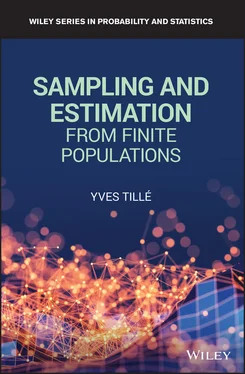18 Chapter 11: Multiple Regression Estimation11.1 Introduction 11.2 Multiple Regression Estimator 11.3 Alternative Forms of the Estimator 11.4 Calibration of the Multiple Regression Estimator 11.5 Variance of the Multiple Regression Estimator 11.6 Choice of Weights 11.7 Special Cases 11.8 Extension to Regression Estimation
19 Chapter 12: Calibration Estimation12.1 Calibrated Methods 12.2 Distances and Calibration Functions 12.3 Solving Calibration Equations 12.4 Calibrating on Households and Individuals 12.5 Generalized Calibration 12.6 Calibration in Practice 12.7 An Example
20 Chapter 13: Model‐Based approach13.1 Model Approach 13.2 The Model 13.3 Homoscedastic Constant Model 13.4 Heteroscedastic Model 1 Without Intercept 13.5 Heteroscedastic Model 2 Without Intercept 13.6 Univariate Homoscedastic Linear Model 13.7 Stratified Population 13.8 Simplified Versions of the Optimal Estimator 13.9 Completed Heteroscedasticity Model 13.10 Discussion 13.11 An Approach that is Both Model‐ and Design‐based
21 Chapter 14: Estimation of Complex Parameters14.1 Estimation of a Function of Totals 14.2 Variance Estimation 14.3 Covariance Estimation 14.4 Implicit Function Estimation 14.5 Cumulative Distribution Function and Quantiles 14.6 Cumulative Income, Lorenz Curve, and Quintile Share Ratio 14.7 Gini Index 14.8 An Example
22 Chapter 15: Variance Estimation by Linearization15.1 Introduction 15.2 Orders of Magnitude in Probability 15.3 Asymptotic Hypotheses 15.4 Linearization of Functions of Interest 15.5 Linearization by Steps 15.6 Linearization of an Implicit Function of Interest 15.7 Influence Function Approach 15.8 Binder's Cookbook Approach 15.9 Demnati and Rao Approach 15.10 Linearization by the Sample Indicator Variables 15.11 Discussion on Variance Estimation
23 Chapter 16: Treatment of Nonresponse 16.1 Sources of Error 16.2 Coverage Errors 16.3 Different Types of Nonresponse 16.4 Nonresponse Modeling 16.5 Treating Nonresponse by Reweighting 16.6 Imputation 16.7 Variance Estimation with Nonresponse
24 Chapter 17: Summary Solutions to the Exercises
25 Bibliography
26 Author Index
27 Subject Index
28 End User License Agreement
1 Chapter 3 Table 3.1 Simple designs: summary table.Table 3.2 Example of sample sizes required for different population sizes and di...
2 Chapter 4Table 4.1 Application of optimal allocation: the sample size is larger than the ...Table 4.2 Second application of optimal allocation in strata 1 and 2.
3 Chapter 5Table 5.1 Minimum support design.Table 5.2 Decomposition into simple random sampling designs.Table 5.3 Decomposition into  simple random sampling designs. Table 5.4 Properties of the methods.
simple random sampling designs. Table 5.4 Properties of the methods.
4 Chapter 6Table 6.1 Population of 20 students with variables, constant, gender (1, male, 2...Table 6.2 Totals and expansion estimators for balancing variables.Table 6.3 Variances of the expansion estimators of the means under simple random...
5 Chapter 7Table 7.1 Block number, number of households, and total household income.
6 Chapter 8Table 8.1 Means of spatial balancing measures based on Voronoï polygons  and mod...Table 8.2 Selection intervals for negative coordination and selection indicators...Table 8.3 Selection indicators for each selection interval for unit
and mod...Table 8.2 Selection intervals for negative coordination and selection indicators...Table 8.3 Selection indicators for each selection interval for unit  .
.
7 Chapter 9Table 9.1 Estimation methods: summary table.
8 Chapter 10Table 10.1 Population partition.Table 10.2 Totals with respect to two variables.Table 10.3 Calibration, starting table.Table 10.4 Salaries in Euros.Table 10.5 Estimated totals using simple random sampling without replacement.Table 10.6 Known margins using a census.Table 10.7 Iteration 1: row total adjustment.Table 10.8 Iteration 2: column total adjustment.Table 10.9 Iteration 3: row total adjustment.Table 10.10 Iteration 4: column total adjustment.Table 1Table 2
9 Chapter 12Table 12.1 Pseudo‐distances for calibration.Table 12.2 Calibration functions and their derivatives.Table 12.3 Minima, maxima, means, and standard deviations of the weights for eac...
10 Chapter 14Table 14.1 Sample, variable of interest  , weights
, weights  , cumulative weights
, cumulative weights  and re...Table 14.2 Table of fictitious incomes
and re...Table 14.2 Table of fictitious incomes  , weights
, weights  , cumulative weights
, cumulative weights  , relati...Table 14.3 Totals necessary to estimate the Gini index.
, relati...Table 14.3 Totals necessary to estimate the Gini index.
11 Chapter 17Table 1Table 2
1 Chapter 1 Figure 1.1 Auxiliary information can be used before or after data collection t...
2 Chapter 4Figure 4.1 Stratified design: the samples are selected independently from one ...
3 Chapter 5Figure 5.1 Systematic sampling: example with inclusion probabilities 



 Figure 5.2 Method of Deville.Figure 5.3 Splitting into two parts.Figure 5.4 Splitting in
Figure 5.2 Method of Deville.Figure 5.3 Splitting into two parts.Figure 5.4 Splitting in  parts.Figure 5.5 Minimum support design.Figure 5.6 Decomposition into simple random sampling designs.Figure 5.7 Pivotal method applied on vector
parts.Figure 5.5 Minimum support design.Figure 5.6 Decomposition into simple random sampling designs.Figure 5.7 Pivotal method applied on vector  .
.
4 Chapter 6Figure 6.1 Possible samples in a population of size  3.Figure 6.2 Fixed size constraint: the three samples of size
3.Figure 6.2 Fixed size constraint: the three samples of size  2 are connected ...Figure 6.3 None of the vertices of
2 are connected ...Figure 6.3 None of the vertices of  is a vertex of the cube.Figure 6.4 Two vertices of
is a vertex of the cube.Figure 6.4 Two vertices of  are vertices of the cube, but the third is not.Figure 6.5 Flight phase in a population of size
are vertices of the cube, but the third is not.Figure 6.5 Flight phase in a population of size  3 with a constraint of fixed...
3 with a constraint of fixed...
Читать дальше

 simple random sampling designs. Table 5.4 Properties of the methods.
simple random sampling designs. Table 5.4 Properties of the methods. and mod...Table 8.2 Selection intervals for negative coordination and selection indicators...Table 8.3 Selection indicators for each selection interval for unit
and mod...Table 8.2 Selection intervals for negative coordination and selection indicators...Table 8.3 Selection indicators for each selection interval for unit  .
. , weights
, weights  , cumulative weights
, cumulative weights  and re...Table 14.2 Table of fictitious incomes
and re...Table 14.2 Table of fictitious incomes  , weights
, weights  , cumulative weights
, cumulative weights  , relati...Table 14.3 Totals necessary to estimate the Gini index.
, relati...Table 14.3 Totals necessary to estimate the Gini index.



 Figure 5.2 Method of Deville.Figure 5.3 Splitting into two parts.Figure 5.4 Splitting in
Figure 5.2 Method of Deville.Figure 5.3 Splitting into two parts.Figure 5.4 Splitting in  parts.Figure 5.5 Minimum support design.Figure 5.6 Decomposition into simple random sampling designs.Figure 5.7 Pivotal method applied on vector
parts.Figure 5.5 Minimum support design.Figure 5.6 Decomposition into simple random sampling designs.Figure 5.7 Pivotal method applied on vector  .
. 3.Figure 6.2 Fixed size constraint: the three samples of size
3.Figure 6.2 Fixed size constraint: the three samples of size  2 are connected ...Figure 6.3 None of the vertices of
2 are connected ...Figure 6.3 None of the vertices of  is a vertex of the cube.Figure 6.4 Two vertices of
is a vertex of the cube.Figure 6.4 Two vertices of  are vertices of the cube, but the third is not.Figure 6.5 Flight phase in a population of size
are vertices of the cube, but the third is not.Figure 6.5 Flight phase in a population of size  3 with a constraint of fixed...
3 with a constraint of fixed...










